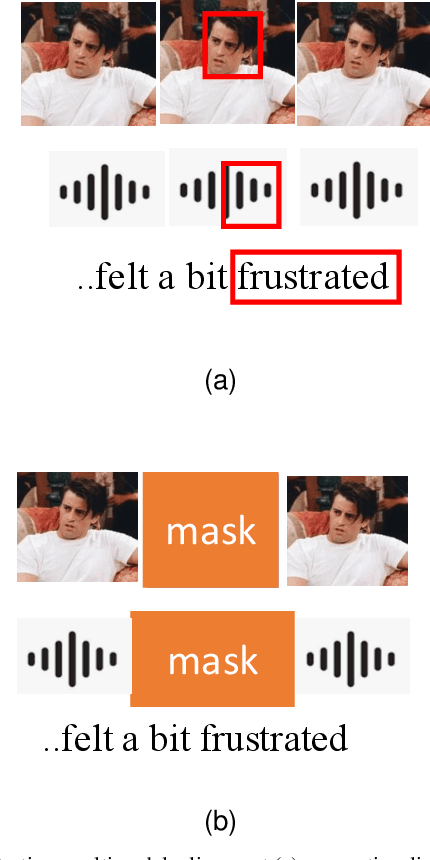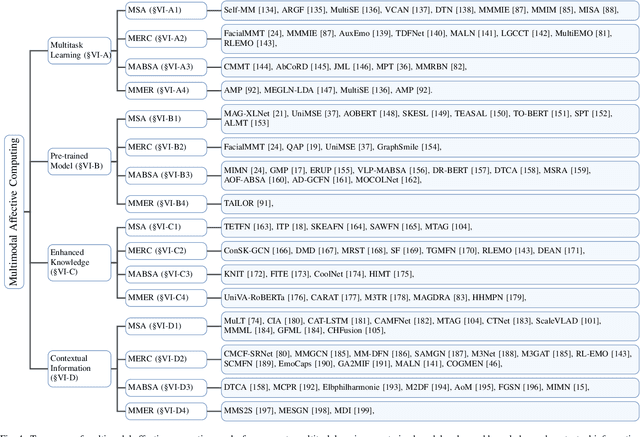Yi Xin
Benchmarking Multimodal Knowledge Conflict for Large Multimodal Models
May 26, 2025Abstract:Large Multimodal Models(LMMs) face notable challenges when encountering multimodal knowledge conflicts, particularly under retrieval-augmented generation(RAG) frameworks where the contextual information from external sources may contradict the model's internal parametric knowledge, leading to unreliable outputs. However, existing benchmarks fail to reflect such realistic conflict scenarios. Most focus solely on intra-memory conflicts, while context-memory and inter-context conflicts remain largely investigated. Furthermore, commonly used factual knowledge-based evaluations are often overlooked, and existing datasets lack a thorough investigation into conflict detection capabilities. To bridge this gap, we propose MMKC-Bench, a benchmark designed to evaluate factual knowledge conflicts in both context-memory and inter-context scenarios. MMKC-Bench encompasses three types of multimodal knowledge conflicts and includes 1,573 knowledge instances and 3,381 images across 23 broad types, collected through automated pipelines with human verification. We evaluate three representative series of LMMs on both model behavior analysis and conflict detection tasks. Our findings show that while current LMMs are capable of recognizing knowledge conflicts, they tend to favor internal parametric knowledge over external evidence. We hope MMKC-Bench will foster further research in multimodal knowledge conflict and enhance the development of multimodal RAG systems. The source code is available at https://github.com/MLLMKCBENCH/MLLMKC.
From Reflection to Perfection: Scaling Inference-Time Optimization for Text-to-Image Diffusion Models via Reflection Tuning
Apr 22, 2025Abstract:Recent text-to-image diffusion models achieve impressive visual quality through extensive scaling of training data and model parameters, yet they often struggle with complex scenes and fine-grained details. Inspired by the self-reflection capabilities emergent in large language models, we propose ReflectionFlow, an inference-time framework enabling diffusion models to iteratively reflect upon and refine their outputs. ReflectionFlow introduces three complementary inference-time scaling axes: (1) noise-level scaling to optimize latent initialization; (2) prompt-level scaling for precise semantic guidance; and most notably, (3) reflection-level scaling, which explicitly provides actionable reflections to iteratively assess and correct previous generations. To facilitate reflection-level scaling, we construct GenRef, a large-scale dataset comprising 1 million triplets, each containing a reflection, a flawed image, and an enhanced image. Leveraging this dataset, we efficiently perform reflection tuning on state-of-the-art diffusion transformer, FLUX.1-dev, by jointly modeling multimodal inputs within a unified framework. Experimental results show that ReflectionFlow significantly outperforms naive noise-level scaling methods, offering a scalable and compute-efficient solution toward higher-quality image synthesis on challenging tasks.
Lumina-Image 2.0: A Unified and Efficient Image Generative Framework
Mar 27, 2025Abstract:We introduce Lumina-Image 2.0, an advanced text-to-image generation framework that achieves significant progress compared to previous work, Lumina-Next. Lumina-Image 2.0 is built upon two key principles: (1) Unification - it adopts a unified architecture (Unified Next-DiT) that treats text and image tokens as a joint sequence, enabling natural cross-modal interactions and allowing seamless task expansion. Besides, since high-quality captioners can provide semantically well-aligned text-image training pairs, we introduce a unified captioning system, Unified Captioner (UniCap), specifically designed for T2I generation tasks. UniCap excels at generating comprehensive and accurate captions, accelerating convergence and enhancing prompt adherence. (2) Efficiency - to improve the efficiency of our proposed model, we develop multi-stage progressive training strategies and introduce inference acceleration techniques without compromising image quality. Extensive evaluations on academic benchmarks and public text-to-image arenas show that Lumina-Image 2.0 delivers strong performances even with only 2.6B parameters, highlighting its scalability and design efficiency. We have released our training details, code, and models at https://github.com/Alpha-VLLM/Lumina-Image-2.0.
TIDE : Temporal-Aware Sparse Autoencoders for Interpretable Diffusion Transformers in Image Generation
Mar 10, 2025Abstract:Diffusion Transformers (DiTs) are a powerful yet underexplored class of generative models compared to U-Net-based diffusion models. To bridge this gap, we introduce TIDE (Temporal-aware Sparse Autoencoders for Interpretable Diffusion transformErs), a novel framework that enhances temporal reconstruction within DiT activation layers across denoising steps. TIDE employs Sparse Autoencoders (SAEs) with a sparse bottleneck layer to extract interpretable and hierarchical features, revealing that diffusion models inherently learn hierarchical features at multiple levels (e.g., 3D, semantic, class) during generative pre-training. Our approach achieves state-of-the-art reconstruction performance, with a mean squared error (MSE) of 1e-3 and a cosine similarity of 0.97, demonstrating superior accuracy in capturing activation dynamics along the denoising trajectory. Beyond interpretability, we showcase TIDE's potential in downstream applications such as sparse activation-guided image editing and style transfer, enabling improved controllability for generative systems. By providing a comprehensive training and evaluation protocol tailored for DiTs, TIDE contributes to developing more interpretable, transparent, and trustworthy generative models.
Lumina-Video: Efficient and Flexible Video Generation with Multi-scale Next-DiT
Feb 10, 2025Abstract:Recent advancements have established Diffusion Transformers (DiTs) as a dominant framework in generative modeling. Building on this success, Lumina-Next achieves exceptional performance in the generation of photorealistic images with Next-DiT. However, its potential for video generation remains largely untapped, with significant challenges in modeling the spatiotemporal complexity inherent to video data. To address this, we introduce Lumina-Video, a framework that leverages the strengths of Next-DiT while introducing tailored solutions for video synthesis. Lumina-Video incorporates a Multi-scale Next-DiT architecture, which jointly learns multiple patchifications to enhance both efficiency and flexibility. By incorporating the motion score as an explicit condition, Lumina-Video also enables direct control of generated videos' dynamic degree. Combined with a progressive training scheme with increasingly higher resolution and FPS, and a multi-source training scheme with mixed natural and synthetic data, Lumina-Video achieves remarkable aesthetic quality and motion smoothness at high training and inference efficiency. We additionally propose Lumina-V2A, a video-to-audio model based on Next-DiT, to create synchronized sounds for generated videos. Codes are released at https://www.github.com/Alpha-VLLM/Lumina-Video.
Customize Your Visual Autoregressive Recipe with Set Autoregressive Modeling
Oct 14, 2024



Abstract:We introduce a new paradigm for AutoRegressive (AR) image generation, termed Set AutoRegressive Modeling (SAR). SAR generalizes the conventional AR to the next-set setting, i.e., splitting the sequence into arbitrary sets containing multiple tokens, rather than outputting each token in a fixed raster order. To accommodate SAR, we develop a straightforward architecture termed Fully Masked Transformer. We reveal that existing AR variants correspond to specific design choices of sequence order and output intervals within the SAR framework, with AR and Masked AR (MAR) as two extreme instances. Notably, SAR facilitates a seamless transition from AR to MAR, where intermediate states allow for training a causal model that benefits from both few-step inference and KV cache acceleration, thus leveraging the advantages of both AR and MAR. On the ImageNet benchmark, we carefully explore the properties of SAR by analyzing the impact of sequence order and output intervals on performance, as well as the generalization ability regarding inference order and steps. We further validate the potential of SAR by training a 900M text-to-image model capable of synthesizing photo-realistic images with any resolution. We hope our work may inspire more exploration and application of AR-based modeling across diverse modalities.
Towards Effective User Attribution for Latent Diffusion Models via Watermark-Informed Blending
Sep 17, 2024Abstract:Rapid advancements in multimodal large language models have enabled the creation of hyper-realistic images from textual descriptions. However, these advancements also raise significant concerns about unauthorized use, which hinders their broader distribution. Traditional watermarking methods often require complex integration or degrade image quality. To address these challenges, we introduce a novel framework Towards Effective user Attribution for latent diffusion models via Watermark-Informed Blending (TEAWIB). TEAWIB incorporates a unique ready-to-use configuration approach that allows seamless integration of user-specific watermarks into generative models. This approach ensures that each user can directly apply a pre-configured set of parameters to the model without altering the original model parameters or compromising image quality. Additionally, noise and augmentation operations are embedded at the pixel level to further secure and stabilize watermarked images. Extensive experiments validate the effectiveness of TEAWIB, showcasing the state-of-the-art performance in perceptual quality and attribution accuracy.
Recent Trends of Multimodal Affective Computing: A Survey from NLP Perspective
Sep 11, 2024



Abstract:Multimodal affective computing (MAC) has garnered increasing attention due to its broad applications in analyzing human behaviors and intentions, especially in text-dominated multimodal affective computing field. This survey presents the recent trends of multimodal affective computing from NLP perspective through four hot tasks: multimodal sentiment analysis, multimodal emotion recognition in conversation, multimodal aspect-based sentiment analysis and multimodal multi-label emotion recognition. The goal of this survey is to explore the current landscape of multimodal affective research, identify development trends, and highlight the similarities and differences across various tasks, offering a comprehensive report on the recent progress in multimodal affective computing from an NLP perspective. This survey covers the formalization of tasks, provides an overview of relevant works, describes benchmark datasets, and details the evaluation metrics for each task. Additionally, it briefly discusses research in multimodal affective computing involving facial expressions, acoustic signals, physiological signals, and emotion causes. Additionally, we discuss the technical approaches, challenges, and future directions in multimodal affective computing. To support further research, we released a repository that compiles related works in multimodal affective computing, providing detailed resources and references for the community.
Enhancing Test Time Adaptation with Few-shot Guidance
Sep 02, 2024Abstract:Deep neural networks often encounter significant performance drops while facing with domain shifts between training (source) and test (target) data. To address this issue, Test Time Adaptation (TTA) methods have been proposed to adapt pre-trained source model to handle out-of-distribution streaming target data. Although these methods offer some relief, they lack a reliable mechanism for domain shift correction, which can often be erratic in real-world applications. In response, we develop Few-Shot Test Time Adaptation (FS-TTA), a novel and practical setting that utilizes a few-shot support set on top of TTA. Adhering to the principle of few inputs, big gains, FS-TTA reduces blind exploration in unseen target domains. Furthermore, we propose a two-stage framework to tackle FS-TTA, including (i) fine-tuning the pre-trained source model with few-shot support set, along with using feature diversity augmentation module to avoid overfitting, (ii) implementing test time adaptation based on prototype memory bank guidance to produce high quality pseudo-label for model adaptation. Through extensive experiments on three cross-domain classification benchmarks, we demonstrate the superior performance and reliability of our FS-TTA and framework.
D2O:Dynamic Discriminative Operations for Efficient Generative Inference of Large Language Models
Jun 18, 2024



Abstract:Efficient inference in Large Language Models (LLMs) is impeded by the growing memory demands of key-value (KV) caching, especially for longer sequences. Traditional KV cache eviction strategies, which prioritize less critical KV-pairs based on attention scores, often degrade generation quality, leading to issues such as context loss or hallucinations. To address this, we introduce Dynamic Discriminative Operations (D2O), a novel method that utilizes two-level discriminative strategies to optimize KV cache size without fine-tuning, while preserving essential context. Initially, by observing varying densities of attention weights between shallow and deep layers, we use this insight to determine which layers should avoid excessive eviction to minimize information loss. Subsequently, for the eviction strategy in each layer, D2O innovatively incorporates a compensation mechanism that maintains a similarity threshold to re-discriminate the importance of previously discarded tokens, determining whether they should be recalled and merged with similar tokens. Our approach not only achieves significant memory savings and enhances inference throughput by more than 3x but also maintains high-quality long-text generation. Extensive experiments across various benchmarks and LLM architectures have demonstrated that D2O significantly enhances performance with a constrained KV cache budget.
 Add to Chrome
Add to Chrome Add to Firefox
Add to Firefox Add to Edge
Add to Edge